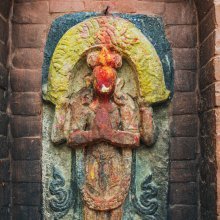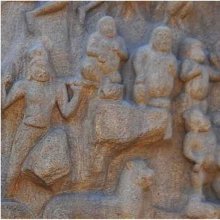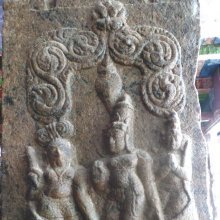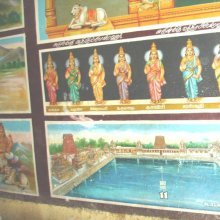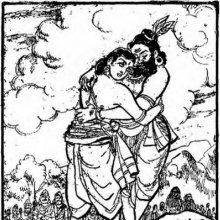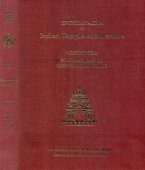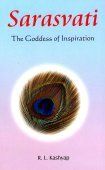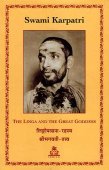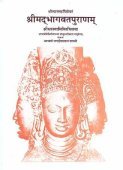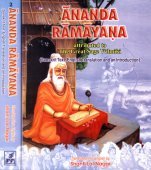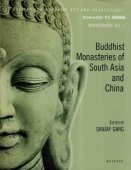Ganga, Gaṅgā, Gāṅga, Gamga: 49 definitions
Introduction:
Ganga means something in Buddhism, Pali, Hinduism, Sanskrit, Jainism, Prakrit, the history of ancient India, Marathi, Hindi, biology. If you want to know the exact meaning, history, etymology or English translation of this term then check out the descriptions on this page. Add your comment or reference to a book if you want to contribute to this summary article.
Images (photo gallery)
(+10 more images available)
In Hinduism
Natyashastra (theatrics and dramaturgy)
Source: archive.org: The mirror of gesture (abhinaya-darpana)One of the Hands of the Famous Rivers.—Gaṅgā, etc., the Tāmracūḍa hand. Also see: Vyāvṛttacāpaveṣṭitau.

Natyashastra (नाट्यशास्त्र, nāṭyaśāstra) refers to both the ancient Indian tradition (shastra) of performing arts, (natya—theatrics, drama, dance, music), as well as the name of a Sanskrit work dealing with these subjects. It also teaches the rules for composing Dramatic plays (nataka), construction and performance of Theater, and Poetic works (kavya).
Vaishnavism (Vaishava dharma)
Source: ISKCON Press: GlossaryGaṅgā (गङ्गा).—The famous and holy Ganges river of India, which runs throughout the entire universe. She originates from the spiritual world, and descended when Lord Vāmanadeva kicked a hole in the top of the universe. One is recommended to bathe in the Ganges for purification. She married Mahārāja Śantanu and begot the famous devotee and warrior, Bhīṣmadeva
Source: Pure Bhakti: Bhagavad-gita (4th edition)Gaṅgā (गङ्गा) refers to “the Ganges, the river of divine water that falls from the spiritual sky to this universe”. (cf. Glossary page from Śrīmad-Bhagavad-Gītā).
Source: Pure Bhakti: Brhad BhagavatamrtamGaṅgā (गङ्गा) refers to:—The holy Ganges River, which flows southeast from the Himālayan Mountains to the Bay of Bengal. Other names include Jāhnavī, Bhāgīrathī, and Alakānanda. (cf. Glossary page from Śrī Bṛhad-bhāgavatāmṛta).

Vaishnava (वैष्णव, vaiṣṇava) or vaishnavism (vaiṣṇavism) represents a tradition of Hinduism worshipping Vishnu as the supreme Lord. Similar to the Shaktism and Shaivism traditions, Vaishnavism also developed as an individual movement, famous for its exposition of the dashavatara (‘ten avatars of Vishnu’).
Purana and Itihasa (epic history)
Source: Wisdom Library: Varāha-purāṇaGaṅgā (गङ्गा).—Name of a river originating from Himālaya, a holy mountain (kulaparvata) in Bhārata, according to the Varāhapurāṇa chapter 85. There are settlements (janapada) where Āryas and Mlecchas dwell who drink water from these rivers.
Bhārata is a region south of Hemādri, once ruled over by Bharata (son of Ṛṣabha), whose ancestral lineage can be traced back to Svāyambhuva Manu, who was created by Brahmā, who was in turn created by Nārāyaṇa, the unknowable all-pervasive primordial being.
Source: Wisdom Library: Bhagavata PuranaGaṅgā (गङ्गा):—Wife of Śāntanu (one of the three sons of Pratīpa). They had a son named Bhīṣma. (see Bhāgavata Purāṇa 9.22.12, 9.22.18-19)
Source: archive.org: Puranic EncyclopediaGaṅgā (गङ्गा).—The famous and holy river of India. Origin and general information. Gaṅgā had its origin during the incarnation of Viṣṇu as Vāmana. When Vāmana measured the three worlds in three steps the nails on his left feet were raised high. They caused a pore on the upper side of the universe. Gaṅgā, starting from the finger of Viṣṇu’s feet fell in heaven (Bhāgavata). (See full article at Story of Gaṅgā from the Puranic encyclopaedia by Vettam Mani)
Source: archive.org: Shiva Purana - English TranslationGaṅgā (गङ्गा) is the name of a river (nadī) and mentioned as one of the seven holy Gaṅgas (saptagaṅgā), according to Śivapurāṇa 1.15. Accordingly, regarding the benefit in the rites of Devayajña:—“[...] a temple, the bank of a holy tank, the bank of an ordinary river, the bank of a holy river and the banks of the seven holy Gaṅgās (saptagaṅgā) are each of ten times more benefit than the previous. The seven holy Gaṅgās are Gaṅgā, Godāvarī, Kāverī, Tāmraparṇikā, Sindhu, Sarayū and Revā. The shores of the sea are of ten times more benefit than the previous. The summit of a mountain is of ten times more benefit than the shores of the sea”.
Source: Cologne Digital Sanskrit Dictionaries: The Purana Index1a) Gaṅgā (गङ्गा).—A river source of, sacred to Hari;1 brought to the earth from Heaven; a mahānadī from the Himalayas.2 Originating from the foot of Viṣṇu and watering the region of the moon falls from heaven into Brahmā's city; issuing from the nail of the great toe of Hari's left foot; Dhruva holds her in his crown; the seven sages perform austerities with her waters; issuing again from the moon she falls on Sumeru and thence to the four quarters of the earth; hearing of her, the desire to go to Gangā, see, touch, bathe in her waters—all purify a person; falling in four directions, takes the names of Śītā, Alakanandā, Cakṣu and Bhadrā.3 Effort made by Aṃśumān, Dilīpa and Bhagīratha and hence her name Bhāgīrathī. Held up by Hara and then let; flowed in seven streams through several territories in the four directions, sanctifying the regions and the people there.4 Its waters drunk by Janhu, and let out by his ears and hence called Jānhavī.5 The seed cast off by Śiva in the sky was borne by Gangā and was swallowed by Agni; phoetus left on the Himalayan slopes became gold, which was utilised in building the yagñaśāla at Naimiṣa. At her confluence with Yamunā (s.v.) was the avabhṛta of the sacrifice of Prajāpatis. On its banks Bharata performed horsesacrifice.6 Here Yudhiṣṭhira had his avabhṛta bath after Rājasūya.7 Here were done funeral rites of the dead children of Draupadī.8 Here again Parīkṣit observed vow of fasting unto death.9 Visited by Balarāma.10 The Sagaras sent to heaven by the Ganges waters.11 Gangā as devī.12 Originally of three-fold path, the Chāyāpathā being in the nakṣatramaṇḍala;13 addressed by Agni to bear Rudra's garbha, Gangā accepted the task and gave birth to Kumāra.14 Gangā refilled the ocean, after Agastya drank it dry.15 Manu put the growing fish in; washed off the city of Hastināpuram; contains 3(1/2) crores of tīrthas; forms the cure for all ills; released in seven streams by Śankara, three to the west, three to the north and one Bhagīrathī, sacred in Kanakhala.16 Wife of the ocean;17 Tripathagā;18 a consort of Śiva, served by Trayambaka and other gods.19 Fit for śrāddha;20 the right side of the Veda;21 particularly sacred at three spots—Gangādvāra, Prayāga and Gangā sāgara-sangama.22
- 1) Bhāgavata-purāṇa VII. 14. 29, VIII. 4. 23, Brahmāṇḍa-purāṇa II. 16. 11, 24.
- 2) Vāyu-purāṇa 42. 39-49: 71. 5.
- 3) Vī. I. 9. 103: II, 2. 334: 8. 108-13, 120-2: III. 14. 18 IV. 4. 26-30: 18-28.
- 4) Bhāgavata-purāṇa IX. 9. 1-13: Brahmāṇḍa-purāṇa III. 13. 118: 55. 51: 56. 38-54.
- 5) Bhāgavata-purāṇa IX. 15. 3: Brahmāṇḍa-purāṇa III. 66. 25-6: 73. 117: Matsya-purāṇa 12. 44: 121. 26.
- 6) Bhāgavata-purāṇa IV. 7. 63-4: Vāyu-purāṇa 2. 17-18: 72. 28-32. Brahmāṇḍa-purāṇa II. 16. 11 and 24. Bhāgavata-purāṇa VII. 14. 29; VIII. 4. 23 Vāyu-purāṇa 42. 39-40: 71. 5. Bhāgavata-purāṇa IX. 9. 1-13. Brahmāṇḍa-purāṇa III. 13. 118: 55.51: 56. 38-54. Matsya-purāṇa 15. 3. Brahmāṇḍa-purāṇa III. 66. 25. 6: 73. 117: Matsya-purāṇa 12. 44: 121. 26. Bhāgavata-purāṇa IV. 7. 63-64. Vāyu-purāṇa 2. 17-18: 72. 28-32. Bhāgavata-purāṇa IV. 2. 35. IX. 20-25: 22. 19: X. 10. 4.
- 7) Bhāgavata-purāṇa X. 75. 19.
- 8) Ib. I. 8. 1.
- 9) Ib. 3. 43; 4. 10; 12. 28; 18. 3.
- 10) Ib. X. 78. 20.
- 11) Ib. IX. 9. 14.
- 12) Ib. I. 19. 15.
- 13) Brahmāṇḍa-purāṇa II. 18. 26-42, 50-52:
- 14) Brahmāṇḍa-purāṇa III. 7. 355: 9. 4: 10. 30-5: 14. 84: 37. 5: 54. 49: IV. 9. 78.
- 15) Brahmāṇḍa-purāṇa III. 63. 167.
- 16) Matsya-purāṇa 1. 23: 13. 25: 36. 5: 50. 78: 102. 5-6: 106. 57-8; 114. 20: 121. 38-41; 133. 23: 183. 107: 186. 10; 192. 11; 239-18.
- 17) Vāyu-purāṇa 13. 35: 30. 32 and 92: 45. 95:
- 18) Vāyu-purāṇa 2. 7; 51. 21, 46; 58. 88.
- 19) Vāyu-purāṇa 42. 39-40: 71. 5.
- 20) Vāyu-purāṇa 77. 68.
- 21) Vāyu-purāṇa 98. 117: 99. 63: 104. 13, 27, 77: 106. 67: 111. 16.
- 22) Matsya-purāṇa 106. 53.
1b) (personified) a bearer of flywhisk to Lalitā.*
- * Bhāgavata-purāṇa VI. 2. 39: Matsya-purāṇa 22. 10: 246. 92.
2) Gāṅga (गाङ्ग).—A Gandharva.*
- * Vāyu-purāṇa 69. 26.
Gaṅgā (गङ्गा) refers to the name of a Lady mentioned in the Mahābhārata (cf. I.61.68). Note: The Mahābhārata (mentioning Gaṅgā) is a Sanskrit epic poem consisting of 100,000 ślokas (metrical verses) and is over 2000 years old.
Gaṅgā also refers to the name of a River or Tīrtha (pilgrim’s destination) mentioned in the Mahābhārata (cf. III.83.4, III.83.63, III.85.10, III.88.23, III.114.2, VI.10.13, VIII.30.10, IX.36.48).
Source: Shodhganga: The saurapurana - a critical studyGaṅgā (गङ्गा) refers to one of the two daughters of Himavān and Menā, according to the Vaṃśa (‘genealogical description’) of the 10th century Saurapurāṇa: one of the various Upapurāṇas depicting Śaivism.—Accordingly, Ākūti was married to Ruci and Prasūti to Dakṣa. Dakṣa produced in Prasūti twenty-four daughters. [...] [Svadhā was given to Pitṛs.] Pitṛ and Svadhā had two daughters—Menā and Dhāriṇi. Menā was given in marriage to Himavān who begot two sons—Maināka and Krauñca and two daughters—Gaurī and Gaṅgā.

The Purana (पुराण, purāṇas) refers to Sanskrit literature preserving ancient India’s vast cultural history, including historical legends, religious ceremonies, various arts and sciences. The eighteen mahapuranas total over 400,000 shlokas (metrical couplets) and date to at least several centuries BCE.
Kavya (poetry)
Source: Shodhganga: The Kavyamimamsa of Rajasekhara1) Gaṅgā (गङ्गा) is the name a river mentioned in Rājaśekhara’s 10th-century Kāvyamīmāṃsā.—Gaṅgā is the holy river of Hindus. In the Kāvyamīmāṃsā, Rājaśekhara mentions Gaṅgā under the list of rivers of the northern and western India. Because the river Ganges flows through both of the parts.
2) Gaṅgā is also the name of place: This region located in the Dakṣiṇāpatha. May be identified as the Kongu country of the southern India, which is comprises on the districts of Coimbatore and Salem. Therefore, according to Belur inscription, this is the part of south Bengal and known as Gange or Gaṅgā. The name Gaṅgā or Kongu seems to have derived from the name of the dynasty of the Western Gaṅgās ruled over the south of Mysore with Salem, Coimbatore, the Nīlgiris and parts of Mālābār. So the Rājaśekhara mentions Gaṅgā country cannot be taken for the represent to Kaliṅga country, which was ruled over by the Eastern Gaṅgā dynasty. Because Rājaśekhara already described Kaliṅga, the district of Ganjam and Vizag amongst the Eastern region countries of India.

Kavya (काव्य, kavya) refers to Sanskrit poetry, a popular ancient Indian tradition of literature. There have been many Sanskrit poets over the ages, hailing from ancient India and beyond. This topic includes mahakavya, or ‘epic poetry’ and natya, or ‘dramatic poetry’.
Shilpashastra (iconography)
Source: Shodhganga: The significance of the mūla-beras (śilpa)1) Gaṅgā (“doll”) refers to one of the several “attributes” (āyudha) or “accessories” of a detiy commonly seen depicted in Hindu iconography, defined according to texts dealing with śilpa (arts and crafs), known as śilpaśāstras.—The śilpa texts have classified the various accessories under the broad heading of āyudha or karuvi (implement), including even flowers, animals, and musical instruments. The other miscellaneous articles found as attributes in the hands of the deities are, for example, Gaṅgā.
2) Gaṅga is the name of a deity depicted in the Aruṇācaleśvar or Arunachaleswara Temple in Thiruvannamalai (Tiruvaṇṇāmalai) which is one of the Pañcasabhā or “five halls where Śiva is said to have danced”.—Gaṅga is found seated in sukhāsana posture with the right hand in kaṭaka and the left hand in dolā-hasta.
Gaṅga is also found depicted near Maṅgalāmbikai in the Adi Kumbeswarar Temple (Ādi Kumbheśvara) in Kumbakonam (Kumbhakonam), representing a sacred place for the worship of Śiva.—Gaṅga is in standing posture with four hands. The upper right hand holds cakra and the upper left hand holds the flower. The lower right hand is in abhaya-hasta and the lower left hand is in urū-hasta.
Source: Shodhganga: Elements of Art and Architecture in the Trtiyakhanda of the Visnudharmottarapurana (shilpa)Gaṅgā (गङ्गा) images are associated with Varuṇa, whose iconography is described in the Viṣṇudharmottarapurāṇa, an ancient Sanskrit text which (being encyclopedic in nature) deals with a variety of cultural topics such as arts, architecture, music, grammar and astronomy.—Varuṇa is known as the lord of water. The images of Gaṅgā and Yamunā are also placed in the right and left side of the image of Varuṇa respectively. The image of Gaṅgā should be placed on a crocodile and should hold cāmara i.e., bushy tail of yak. The Viṣṇudharmottarapurāṇa states that the image of Yamunā should be placed on a tortoise and also have cāmara in her hand.

Shilpashastra (शिल्पशास्त्र, śilpaśāstra) represents the ancient Indian science (shastra) of creative arts (shilpa) such as sculpture, iconography and painting. Closely related to Vastushastra (architecture), they often share the same literature.
Ayurveda (science of life)
Dietetics and Culinary Art (such as household cooking)
Source: Shodhganga: Dietetics and culinary art in ancient and medieval IndiaGaṅgā (गङ्गा) is an important river whose water (jala) qualities are described in the Bhojanakutūhala (dravyaguṇāguṇa-kathana), and is commonly found in literature dealing with the topics of dietetics and culinary art, also known as Pākaśāstra or Pākakalā.—Different types of water (jala) and their properties are mentioned here [viz., in jala-prakaraṇa]. The text explains the qualities of the water of certain important rivers like [viz., Gaṅgā].
Unclassified Ayurveda definitions
Source: archive.org: Vagbhata’s Ashtanga Hridaya Samhita (first 5 chapters)Gāṅga (गाङ्ग) refers to “Gangetic water”, as mentioned in verse 5.3 of the Aṣṭāṅgahṛdayasaṃhitā (Sūtrasthāna) by Vāgbhaṭa.—Accordingly, “[...] if, berained [viz., abhivṛṣṭa] by it, stainless rice-pap kept in a silver bowl (remains) unputrid and undiscoloured, it (is) to be drunk [viz. peya] as Gangetic (water) [viz., gāṅga]. Otherwise, (it is) oceanic (water); this (is) not to be drunk except in the month of Āśvayuja”.
Note: Gāṅga [gāṅgam] (sc. ambu) (“Gangetic water”) has been placed at the head of the pāda and rendered by gāṅgai chu (“Ganges water”) (again spelt gaṅ-gāi chu in CD), with the ellipsis duly completed. The following de, which reproduces tat, has been corrupted to ste in NP.

Āyurveda (आयुर्वेद, ayurveda) is a branch of Indian science dealing with medicine, herbalism, taxology, anatomy, surgery, alchemy and related topics. Traditional practice of Āyurveda in ancient India dates back to at least the first millenium BC. Literature is commonly written in Sanskrit using various poetic metres.
Kavyashastra (science of poetry)
Source: Shodhganga: Bhismacaritam a critical studyGaṅgā (गङ्गा) figures as a female character in the Bhīṣmacarita (Bhishma Charitra) which is a mahākāvya (‘epic poem’) written by Hari Narayan Dikshit.—Gaṅgā was a beautiful woman. She was also a devout wife and looked after the King Śāntanu with love and affection. They were staying happily. After sometime Gaṅgā gave birth to a bright son who was named Devavrata, but she could not bear the pain of post pregnancy and died immediately leaving his son in the hands of king. The King was loving her so much that he could not forget her even after many days of her death and was remaining sad in her memory

Kavyashastra (काव्यशास्त्र, kāvyaśāstra) refers to the ancient Indian tradition of poetry (kavya). Canonical literature (shastra) of the includes encyclopedic manuals dealing with prosody, rhetoric and various other guidelines serving to teach the poet how to compose literature.
Shaktism (Shakta philosophy)
Source: Google Books: ManthanabhairavatantramGaṅgā (गङ्गा) refers to the Ganges river and is used to describe Śaṃkara (i.e., Bhairava), according to the second recension of the Yogakhaṇḍa of the Manthānabhairavatantra, a vast sprawling work that belongs to a corpus of Tantric texts concerned with the worship of the goddess Kubjikā.—Accordingly, as the Goddess (i.e., Khageśī) said to the God (i.e., Bhairava), “[...] Give up the ash, the matted hair and the form with five faces. Give up the bones and skull and (all) else that is artificial. Give up (the practice of ritual) gestures, the Moon and the sacred thread. Give up the bull and the Ganges [i.e., gaṅgā]. Give up (your) spear and the great serpent, the ascetic's staff and, O god, the garland of severed heads and the skull. Accomplishment (siddhi) (can only be found) in Kula, Kaula and the Western (transmission) of Sadyojāta. [...]”.

Shakta (शाक्त, śākta) or Shaktism (śāktism) represents a tradition of Hinduism where the Goddess (Devi) is revered and worshipped. Shakta literature includes a range of scriptures, including various Agamas and Tantras, although its roots may be traced back to the Vedas.
General definition (in Hinduism)
Source: Wisdom Library: HinduismGaṅgā (गङ्गा) is a Sanskrit word referring to a dwelling place or resort of the celestial nymphs (apsaras). They live chiefly on earth around rivers or on mountains, as in the courts of all the gods.
In Buddhism
Theravada (major branch of Buddhism)
Source: Pali Kanon: Pali Proper Names1. Ganga (Modern Ganges) - One of the five great rivers (Mahanadi) that water Jambudipa, the others being Yamuna, Aciravati, Sarabhu, and Mahi (E.g., Vin.ii.237; S.ii.135; v.401; A.iv.101; v.22; Mil.114 mentions ten).
The Commentaries (E.g., SNA.ii.438f; AA.ii.761ff; MA.ii.586; UdA.301) give a long description of their origin. From the Anotatta lake flow four rivers: that from the south circles the lake three times under the name of Avattaganga, then as Kanhaganga flows straight for sixty leagues along the surface of a rock, comes into violent contact with a vertical rock, and is thrown upwards as a column of water three gavutas in circumference; this column, known as Akasaganga, flows through the air for sixty leagues, falls on to the rock Tiyaggala, excavating it to a depth of fifty leagues, thus forming a lake which is called Tiyaggalapokkharani; then the river, under the name of Bahalaganga, flows through a chasm in the rock for sixty leagues, then, under the name of Ummaggaganga, through a tunnel for a further sixty leagues, and finally coming upon the oblique rock Vijjha, divides into five streams, forming the five rivers above mentioned.
Among places mentioned as being on the banks of the Ganga are Benares, Campa, Ayojjha, Kimbhila, Ukkavela, Payaga, Pataliputta, and Sankassa. The Ganga formed one of the most important means of communication and trade for the districts through which it flowed - e.g., from Rajagaha to Vesali. The district to the north of the river and bordering on the kingdom of Anga was called Anguttarapa (SNA.ii.439). The river was five hundred leagues in length (SA.ii.119).
The name of the Ganga appears again and again in similes and metaphors in the Pali books:
its sands are immeasurable (S.iv.376);
its waters cannot be made bracken by adding to them a grain of salt (A.i.250);
it is full of foam, and yet its foam is empty (S.iii.140);
it were folly to wish to hold up the course of its waters with ones fist (S.iv.298);
as the river finds repose only in the ocean, so do the followers of the Buddha find repose only in nibbana (M.i.493);
some things are as inevitable as that the Ganga should flow into the sea (S.iv.179);
there is no such thing as the Ganga apart from its sand, its water, and its banks;
to be cast on the other side of the Ganga (paragangaya) is great misfortune (see, e.g., S.i.207, SnA.i.228).
The Ganga flows from west to east (pacinaninna, S.iv.191);
during the rains it is so full of water that even a crow could drink water from its bank (Vin.i.230);
sometimes the banks would be flooded and the buildings on them destroyed (SA.i.164), and people would find difficulty in crossing;
Theravāda is a major branch of Buddhism having the the Pali canon (tipitaka) as their canonical literature, which includes the vinaya-pitaka (monastic rules), the sutta-pitaka (Buddhist sermons) and the abhidhamma-pitaka (philosophy and psychology).
Mahayana (major branch of Buddhism)
Source: Wisdom Library: Maha Prajnaparamita SastraGaṅgā (गङ्गा) is the name of a river originating from the eastern corner of lake Anavatapta in mount Himavat (‘the Snowy Mountains’) to the north, according to Mahāprajñāpāramitāśāstra (chapter XIV). Accordingly, The Gaṅgā comes from the mountain in the north and empties into the eastern ocean (pūrvasamudra).
The Ganges is the most important of these four rivers; people come there from the four directions of space and consider it to be a sacred river, the sins (āpatti), stains (mala) and faults (pāpa) of those who bathe there are completely removed. Since all people venerate and know this river, the sands of the Ganges are taken as comparison (“as numerous as the sands of the Ganges”).

Mahayana (महायान, mahāyāna) is a major branch of Buddhism focusing on the path of a Bodhisattva (spiritual aspirants/ enlightened beings). Extant literature is vast and primarely composed in the Sanskrit language. There are many sūtras of which some of the earliest are the various Prajñāpāramitā sūtras.
Tibetan Buddhism (Vajrayana or tantric Buddhism)
Source: 84000: The Basket’s DisplayGaṅga (गङ्ग) (identified with the Ganges river) refers to one of the great rivers of Jambudvīpa, according to the Kāraṇḍavyūha-sūtra chapter 2 (“”).—Accordingly, as Tathāgata Padmottama praises the qualities of this six-syllable mahāvidyā: “As a comparison, in Jambudvīpa there are great rivers that flow day and night. They are the [e.g., Gaṅga, Ganges] [...]. Each of these rivers has five hundred tributaries. Day and night they flow into the ocean. Noble son, this is how the accumulation of merit increases as the result of a single repetition of the six-syllable mahāvidyā: I can count each drop in those great rivers, but, noble son, I cannot calculate the accumulation of merit that comes from repeating the six-syllable mahāvidyā once”.
Source: academia.edu: Studies in History, Myths, Rituals and Beliefs in TibetGanga is the name of a River situated in the land of 'ol-mo lung-ring, according to the gZer mig (by Drang-rje btsun-pa gSer-mig): an ancient Tibetan text dealing Bon: an indigenous shamanistic tradition of Tibet.—Accordingly, Bonpo tradition maintains that the ultimate source of Bon is the land of 'ol-mo lung-ring, said to be a part of sTag-gzig (Tazig). [...] The land is dominated by Mount g.Yung-drung dgu-brtsegs—literally ‘pile of nine swastikas’. [...] The nine stages of Mount gYung-drungdgu-brtsegs are said to represent the nine ways of Bon. One strange thing about this mountain is that its peak is in the form of a crystal monolith referring originally no doubt to its snowy or glacial summit. Later on conspicuous importance was attached to this crystal monolith. Four rives flow from the base of the mountain g.Yung-drungdgu-brtsegs in the four directions. [For example]: In the west the river Ganga flows from the mouth of an elephant (Glang-chen kha-'babs); Hundreds of temples, cities and parks are said to be in the vicinity of the mountain, but only eight centres stand out as worthy of note.

Tibetan Buddhism includes schools such as Nyingma, Kadampa, Kagyu and Gelug. Their primary canon of literature is divided in two broad categories: The Kangyur, which consists of Buddha’s words, and the Tengyur, which includes commentaries from various sources. Esotericism and tantra techniques (vajrayāna) are collected indepently.
In Jainism
General definition (in Jainism)
Source: Wisdom Library: JainismGaṅgā (गङ्गा) is the name of a river mentioned as flowing through Bhārata together with the Sindhu river. Bhārata is one of the seven regions (kṣetra) of Jambūdvīpa according to Jaina cosmology. Jambūdvīpa sits at the centre of madhyaloka (‘middle world’) is the most important of all continents and it is here where human beings reside.
Source: archive.org: TrisastisalakapurusacaritraGaṅgā (गङ्गा) and Sindhu are two great rivers situated in the Bhārata (Bharatakṣetra) zone of Jambūdvīpa which is situated in the “middle world” (madhyaloka), according to chapter 2.2 [ajitanātha-caritra] of Hemacandra’s 11th century Triṣaṣṭiśalākāpuruṣacaritra: an ancient Sanskrit epic poem narrating the history and legends of sixty-three illustrious persons in Jainism.
Accordingly:—“In Bharatakṣetra there are the great rivers, Gaṅgā and Sindhu; in the zone named Haimavata, Rohitā and Rohitāṃśā; in the Harivarṣaka zone, the rivers Harit and Harikāntā; in the Mahāvidehas the best rivers Śītā and Śītodā Narakāntā and Narīkāntā in the zone Ramyaka; Svarṇakūlā and Rūpyakūlā in the zone Hairaṇyavata; Raktā and Raktodā in the zone Airāvata. The first of each pair flows to the east and the second to the west. The great rivers Gaṅgā and Sindhu are each attended by 14,000 best rivers. Each pair of the others is attended by twice as many rivers as the preceding pair up to Śītā and Śītodā. The northern rivers (north of Videha) are equal to the southern. Śītā and Śītodā, however, are attended by 532,000 rivers each”.
Source: HereNow4u: Lord Śrī MahāvīraGaṅgā (गङ्गा) is the name of river crossed by Mahāvīra during his second year of spiritual-exertion.—Leaving Śvetāmbikā city, the Lord moved towards Surabhipura. River Gaṅgā came mid-way. The Lord had to sit on a boat to cross Gaṅgā. When Mahāvīra crossed Gaṅgā, two Nāga princes Kambala and Śambala served the Lord to get over this calamity.
Source: Encyclopedia of Jainism: Tattvartha Sutra 3: The Lower and middle worldsGaṅga (गङ्ग) is the name of a river that, coupled with the Sindhu river, separates the Bharata region. Bharata refers to one of the regions of Jambūdvīpa: the first continent of the Madhya-loka (middle-word), according to the 2nd-century Tattvārthasūtra 3.10. The Gaṅga river flow eastwards. The Gaṅga and Sindhu rivers have 14000 tributaries.
Jambūdvīpa (where flows the Gaṅga river) is in the centre of all continents and oceans; all continents and oceans are concentric circles with Jambūdvīpa in the centre. Like the navel is in the centre of the body, Jambūdvīpa is in the centre of all continents and oceans. Sumeru Mount is in the centre of Jambūdvīpa. It is also called Mount Sudarśana.

Jainism is an Indian religion of Dharma whose doctrine revolves around harmlessness (ahimsa) towards every living being. The two major branches (Digambara and Svetambara) of Jainism stimulate self-control (or, shramana, ‘self-reliance’) and spiritual development through a path of peace for the soul to progess to the ultimate goal.
India history and geography
Source: Wisdom Library: India HistoryGāṅga (गाङ्ग) is the name of a country included within Dakṣiṇapatha which was situated ahead of Māhiṣmatī according to Rājaśekhara (fl. 10th century) in his Kāvyamīmāṃsā (chapter 17). Dakṣiṇāpatha is a place-name ending is patha mentioned in the Gupta inscriptions. The Gupta empire (r. 3rd-century CE), founded by Śrī Gupta, covered much of ancient India and embraced the Dharmic religions such as Hinduism, Buddhism and Jainism.
Source: archive.org: Geography in Ancient Indian inscriptionsGaṅgā (गङ्गा).—The river is known by the same name even today. Regarding this river, and its tributaries, Arrian observes: “Megasthenes states that of the two (the Ganges and the Indus), the Ganges is much the larger............ It receives, besides the river Sonos and the Sittokatis and Solomatis, which are also navigable and also the Kondochates and the Sambos and the Magon and the Agoranis and the Omalis. Moreover, there falls into it the Kommenases, a great river, and the Kakouthis and the Andomatis.”
Source: archive.org: Personal and geographical names in the Gupta inscriptionsGaṅgā (गङ्गा) is the name of a river mentioned in the Gupta inscription No. 1 and 13. The Gupta empire (r. 3rd-century CE), founded by Śrī Gupta, covered much of ancient India and embraced the Dharmic religions such as Hinduism, Buddhism and Jainism. We do find the word in the Uṇādi affixes. The affix gan comes after the root gaṃ ‘to go’ and the word Gaṅgā is formed.
The Gaṅgā emerges first in the Gangotri in the district of Garhwal and proceeds in different courses from Hardwar to Bulandshahar and from Allahabad to Rajmahal from where it enters Bengal.
Source: archive.org: Nilamata Purana: a cultural and literary study (history)Gaṅgā (गङ्गा) is the name of a river mentioned in the Nīlamatapurāṇa that corresponds with the Sindh (Sindhu).—Many rivers and rivulets in Kaśmīra are named Gaṅgā but the Nīlamata uses this designation specifically for the Sindhu not to be confused with the Indus. Formed by two streams which unite at Baltal, this river Sind flows over a rocky bed in a westerly direction and receives many tributaries in the way, the principal being Kanakavāhinī joining it near the village of Kijpara in the Jar Pargana. Having reached Kaśmīra, it turns towards the northwest and joins the Vitastā at Shadipur. The Nīlamata praises highly the confluence of the Sindhu with the Kanakavāhinī and the Vitastā.
Source: Ancient Buddhist Texts: Geography of Early BuddhismGaṅgā (गङ्गा) is the name of a river situated in Majjhimadesa (Middle Country) of ancient India, as recorded in the Pāli Buddhist texts (detailing the geography of ancient India as it was known in to Early Buddhism).—The river Gaṅga has been mentioned frequently in ancient Pāli literature, and is identical with the great sacred river on the banks of which the drama of Indian History has so often been enacted—the Ganges which is famous in early, mediaeval and modern history of India. According to the Sigāla Jātaka she flowed by the city of Bārāṇasī. There is a confluence between this river and Yamunā (cf. Sumaṅgalavilāsinī).

The history of India traces the identification of countries, villages, towns and other regions of India, as well as mythology, zoology, royal dynasties, rulers, tribes, local festivities and traditions and regional languages. Ancient India enjoyed religious freedom and encourages the path of Dharma, a concept common to Buddhism, Hinduism, and Jainism.
Biology (plants and animals)
Source: Google Books: CRC World Dictionary (Regional names)1) Ganga in East Africa is the name of a plant defined with Euphorbia nyikae in various botanical sources. This page contains potential references in Ayurveda, modern medicine, and other folk traditions or local practices.
2) Ganga in Upper Volta is also identified with Sporobolus pyramidalis It has the synonym Agrostis indica sensu Forssk. (etc.).
Example references for further research on medicinal uses or toxicity (see latin names for full list):
· Prodromus Florae Novae Hollandiae (1810)
· Enumeratio Plantarum Omnium Hucusque Cognitarum (1833)
· Blumea (1991)
· Kew Bulletin (1965)
· Flore d’Oware (1816)
· Nomenclator Botanicus. Editio secunda (1843)
If you are looking for specific details regarding Ganga, for example diet and recipes, pregnancy safety, health benefits, chemical composition, extract dosage, side effects, have a look at these references.

This sections includes definitions from the five kingdoms of living things: Animals, Plants, Fungi, Protists and Monera. It will include both the official binomial nomenclature (scientific names usually in Latin) as well as regional spellings and variants.
Languages of India and abroad
Pali-English dictionary
Source: BuddhaSasana: Concise Pali-English Dictionarygaṅgā : (f.) river; the Ganges.

Pali is the language of the Tipiṭaka, which is the sacred canon of Theravāda Buddhism and contains much of the Buddha’s speech. Closeley related to Sanskrit, both languages are used interchangeably between religions.
Marathi-English dictionary
Source: DDSA: The Molesworth Marathi and English Dictionarygaṅgā (गंगा).—f (S) The river Ganges or the personification of it as a goddess. 2 The river Goda or Godavari. 3 A sacred stream gen. Pr. vāhatī gaṅgā āṇi cālatā dharma. 4 Water from a sacred stream or consecrated water, for sacred uses and purposes. gaṅgēntalēṃ pāṇī gaṅgēnta sōḍaṇēṃ A phrase used humbly by a person in repaying kind offices. gaṅgēsa ghōḍē nāhaṇēṃ To accomplish a mighty undertaking or achieve some great feat. vāhatē gaṅgēnta hāta dhuṇēṃ To take a part in, and thus seize a share of the merit of, some puṇyakarma that another is carrying on. vāhilī tī gaṅgā rāhilēṃ tēṃ tīrtha Used of profuse and generous largesses or expenditure. Because both the money spent and the money saved will profit.
--- OR ---
gāṅgā (गांगा).—a White with a reddish cast or tint. A color of horses.
Source: DDSA: The Aryabhusan school dictionary, Marathi-Englishgaṅgā (गंगा).—f The river Ganges. Consecrated water. gaṅgēta ghōḍē nāhaṇēṃ Accomplish a mighty undertaking.
--- OR ---
gāṅgā (गांगा).—a White with a reddish t
Marathi is an Indo-European language having over 70 million native speakers people in (predominantly) Maharashtra India. Marathi, like many other Indo-Aryan languages, evolved from early forms of Prakrit, which itself is a subset of Sanskrit, one of the most ancient languages of the world.
Sanskrit dictionary
Source: DDSA: The practical Sanskrit-English dictionaryGaṅgā (गङ्गा).—[gam-gan; Uṇādi-sūtra 1.12]
1) The river Ganges, the most sacred river in India; अधोधो गङ्गेयं पदमुपगता स्तोकमथवा (adhodho gaṅgeyaṃ padamupagatā stokamathavā) Bhartṛhari 2.1; R.2.26;13.57; (mentioned in Ṛgveda 1.75.5, along with other rivers considered sacred in India).
2) The Ganges personified as a goddess. [Gaṅgā is the eldest daughter of Himavat. It is said that a curse of Brahmā made her come down upon earth, where she became the first wife of King Śantanu. She bore him eight sons, of whom Bhīṣma, the youngest, became a well-known personage, renowned for his valour and life-long celibacy. According to another account she came down on earth being propitiated by Bhagīratha; see भगीरथ (bhagīratha) and जह्नु (jahnu) also; and cf. Bhartṛhari 2. 1]. इमं मे गङ्गे यमुने सरस्वति (imaṃ me gaṅge yamune sarasvati) Mahānār. Up.5.4.
--- OR ---
Gāṅga (गाङ्ग).—a. (-ṅgī f.) [गङ्गाया अपत्यं अण् (gaṅgāyā apatyaṃ aṇ)]
1) Being in or on the Ganges.
2) Coming from or relating to the Ganges; गाङ्गमम्बु सितमम्बु यामुनं कज्जलाभमुभयत्र मज्जतः (gāṅgamambu sitamambu yāmunaṃ kajjalābhamubhayatra majjataḥ) K. P.1; Kumārasambhava 5.37.
-ṅgaḥ 1 An epithet of Bhīṣma.
2) Of Kārtikeya.
-ṅgam 1 Rain-water of a peculiar kind (supposed to fall down from the heavenly Ganges).
2) Gold.
-ṅgī An epithet of Durgā.
Source: Cologne Digital Sanskrit Dictionaries: Edgerton Buddhist Hybrid Sanskrit DictionaryGaṅga (गङ्ग).—name of a merchant: Avadāna-śataka ii.53.3 ff.
Source: Cologne Digital Sanskrit Dictionaries: Shabda-Sagara Sanskrit-English DictionaryGaṅgā (गङ्गा).—f.
(-ṅgā) The river Ganges, or its personification as a goddess. E. gam to go, Unadi affix gan, or gāṃ the accusative of go the earth, and ga who goes, form irr.
--- OR ---
Gāṅga (गाङ्ग).—mfn.
(-ṅgaḥ-ṅgī-ṅgaṃ) Belonging or relating to the river Ganges. m.
(-ṅgaḥ) 1. A name of Kartikeya. 2. A name of Bhishma E. gaṅgā the Ganga, aṇ aff.
Source: Cologne Digital Sanskrit Dictionaries: Benfey Sanskrit-English DictionaryGaṅgā (गङ्गा).— (from *gaṅgam for jaṅgam, frequentat. of gam), f. The river Ganges, supposed to exist also in the sky and in the lower regions, Ram. 1, 44, 14.
--- OR ---
Gāṅga (गाङ्ग).—i. e. gaṅgā + a, I. adj., f. gī. 1. Belonging to the Gaṅga, Mahābhārata 7, 2215. Ii. n. The name of a kind of rain-water (ascribed to the celestial Gaṅgā), [Suśruta] 1, 170, 2.
Source: Cologne Digital Sanskrit Dictionaries: Cappeller Sanskrit-English DictionaryGaṅgā (गङ्गा).—[feminine] the river Ganges (often personif.).
--- OR ---
Gāṅga (गाङ्ग).—[feminine] ī being on or in the Ganges, coming from it, etc.; [masculine] metron. of Bhisma.
Source: Cologne Digital Sanskrit Dictionaries: Monier-Williams Sanskrit-English Dictionary1) Gaṅga (गङ्ग):—(in [compound] for ṅgā, [Pāṇini 6-3, 63]).
2) m. a kind of deer, [cf. Lexicographers, esp. such as amarasiṃha, halāyudha, hemacandra, etc.]
3) Name of a dynasty, [Inscriptions]
4) Gaṅgā (गङ्गा):—[from gaṅga] f. (√gam, [Uṇādi-sūtra]) ‘swift-goer’, the river Ganges (personified and considered as the eldest daughter of Himavat and Menā, [Rāmāyaṇa i, 36, 15]; as the wife of Śāntanu and mother of Bhīṣma, [Mahābhārata i, 3800; Harivaṃśa 2967 ff.]; or as one of the wives of Dharma, [Padma-purāṇa] ; there is also a Gaṅgā in the sky [ākāśaor vyoma-g, qq.vv.; cf. khāpagā, gaganāpagā etc.] and one below the earth, [Harivaṃśa 12782]; Bhagī-ratha is said to have conducted the heavenly Gaṅgā down to the earth, [810 ff.; Rāmāyaṇa i, [chapter] 44]), [Ṛg-veda x, 75, 5; Śatapatha-brāhmaṇa xiii; Taittirīya-āraṇyaka etc.]
5) [v.s. ...] Name of the wife of Nīla-kaṇṭha and mother of Śaṃkara
6) [v.s. ...] ifc. See dviveda-gaṅga.
7) Gāṅga (गाङ्ग):—mf(ī)n. ([from] gaṅgā), being in or on the Ganges, coming from or belonging or relating to the Ganges, [Mahābhārata] (hrada, [v, 996]), [Rāmāyaṇa; Kumāra-sambhava v, 37 etc.]
8) m. ([gana] śivādi) [metronymic] of Bhīṣma (cf. gāṅgāyani), [Harivaṃśa 1824]
9) of Skanda or Kārttikeya, [cf. Lexicographers, esp. such as amarasiṃha, halāyudha, hemacandra, etc.]
10) n. ([scilicet] ambu) rain-water of a peculiar kind (supposed to be from the heavenly Ganges), [Suśruta i, 45, 1, 1]
Source: Cologne Digital Sanskrit Dictionaries: Yates Sanskrit-English Dictionary1) Gaṅgā (गङ्गा):—(ṅgā) 1. f. The river Ganges or the personification of it.
2) Gāṅga (गाङ्ग):—[(ṅgaḥ-ṅgī-ṅgaṃ) a.] Of the river Ganges. m. Kārtikeya, Bhīshma.
Source: DDSA: Paia-sadda-mahannavo; a comprehensive Prakrit Hindi dictionary (S)Gaṅga (गङ्ग) in the Sanskrit language is related to the Prakrit words: Gaṃga, Gaṃgā.
[Sanskrit to German]
Sanskrit, also spelled संस्कृतम् (saṃskṛtam), is an ancient language of India commonly seen as the grandmother of the Indo-European language family (even English!). Closely allied with Prakrit and Pali, Sanskrit is more exhaustive in both grammar and terms and has the most extensive collection of literature in the world, greatly surpassing its sister-languages Greek and Latin.
Hindi dictionary
Source: DDSA: A practical Hindi-English dictionaryGanga in Hindi refers in English to:—(nm) the Ganges (considered to be the most sacred river by the Hindus); —[jamuni] made up of two colours or two metals (like gold and silver); ~[jala] sacred water of the Ganges; ~[jali] a metal goblet to preserve the holy water of the Ganges; •[uthana] to swear by the water of the Ganges; —[nahana] to accomplish a difficult task; to achieve a destination..—ganga (गंगा) is alternatively transliterated as Gaṃgā.
...
Prakrit-English dictionary
Source: DDSA: Paia-sadda-mahannavo; a comprehensive Prakrit Hindi dictionary1) Gaṃga (गंग) in the Prakrit language is related to the Sanskrit word: Gaṅga.
2) Gaṃgā (गंगा) also relates to the Sanskrit word: Gaṅgā.
Prakrit is an ancient language closely associated with both Pali and Sanskrit. Jain literature is often composed in this language or sub-dialects, such as the Agamas and their commentaries which are written in Ardhamagadhi and Maharashtri Prakrit. The earliest extant texts can be dated to as early as the 4th century BCE although core portions might be older.
Kannada-English dictionary
Source: Alar: Kannada-English corpusGāṃga (ಗಾಂಗ):—[adjective] of, relating to, getting or got from, the river Gaṃgā.
--- OR ---
Gāṃga (ಗಾಂಗ):—[noun] gold.
Kannada is a Dravidian language (as opposed to the Indo-European language family) mainly spoken in the southwestern region of India.
See also (Relevant definitions)
Starts with (+269): Gamgabhavani, Gamgadhisha, Gamgadikara, Gamgagarike, Gamgahimakaravaha, Gamgajamuna, Gamgajul, Gamgajuta, Gamgakaveri, Gamgalamurage, Gamgalamurige, Gamgamauli, Gamganamara, Gamgane, Gamganvaya, Gamgapani, Gamgaphala, Gamgara, Gamgasa, Gamgasamaradhane.
Ends with (+96): Abhraganga, Adhoganga, Adyaganga, Ahoganga, Akashaganga, Alashavara-ganga, Ambaganga, Ambanganga, Antaraganga, Antarganga, Anuganga, Arddhaganga, Ardhaganga, Avattaganga, Avyanganga, Bahalaganga, Banaganga, Barganga, Bhavishyaganga, Bhoganga.
Full-text (+1109): Gangatira, Gangajala, Unmattaganga, Gangodaka, Gangaputra, Gangavatarana, Gangambu, Gangapara, Gangamahatmya, Gangika, Ganga-snana, Gangasagara, Gangahrada, Gangashona, Gangakshetra, Gangabhrit, Saptaganga, Gangaja, Gangacilli, Gangi.
Relevant text
Search found 169 books and stories containing Ganga, Gamga, Gaṃga, Gaṃgā, Gāṃga, Gaṅgā, Gāṅga, Gāṅgā, Gaṅga, Gaṅga°; (plurals include: Gangas, Gamgas, Gaṃgas, Gaṃgās, Gāṃgas, Gaṅgās, Gāṅgas, Gāṅgās, Gaṅgas, Gaṅga°s). You can also click to the full overview containing English textual excerpts. Below are direct links for the most relevant articles:
Garga Samhita (English) (by Danavir Goswami)
Verse 2.3.21 < [Chapter 3 - Description of the Yamunā’s Arrival]
Verse 2.18.22 < [Chapter 18 - The Sight of Śrī Kṛṣṇacandra]
Verse 4.8.33 < [Chapter 8 - In the Story of the Yajña-sītās, the Glories of Ekādaśī]
Chaitanya Bhagavata (by Bhumipati Dāsa)
Verse 3.1.121 < [Chapter 1 - Meeting Again at the House of Śrī Advaita Ācārya]
Verse 2.1.142 < [Chapter 1 - The Beginning of the Lord’s Manifestation and His Instructions on Kṛṣṇa-saṅkīrtana]
Verse 1.13.49 < [Chapter 13 - Defeating Digvijayī]
Dvisahasri of Tembesvami (Summary and Study) (by Upadhyay Mihirkumar Sudhirbhai)
Appendix 5 - Holy places mentioned in the Dvisāhasrī
Appendix 4 - Some Important words employed in the Dvisāhasrī
Biography of H. H. Ṭembesvāmī < [H. H. Ṭembesvāmī: Life, Date & Works]
Matangalila and Hastyayurveda (study) (by Chandrima Das)
The gaja-śārdula concept < [Chapter 2]
Depiction of elephants on the royal seals and inscription-slabs/plates < [Chapter 2]
Bhagavatpadabhyudaya by Lakshmana Suri (study) (by Lathika M. P.)
Canto IV—Depicting of Commentary < [Chapter 2 - Content Analysis of Bhagavatpādābhyudaya]
Hostile Accounts and Controversies < [Chapter 4 - Similarities and Dissimilarities]
Dispute over Śaṅkara’s Birth Place < [Chapter 4 - Similarities and Dissimilarities]
Trishashti Shalaka Purusha Caritra (by Helen M. Johnson)
Part 9: Diversion of the Gaṅga into the moat < [Chapter V - Life and death of the sons of Sagara]
Part 7: The sixth spoke < [Chapter XIII - Śrī Mahāvīra’s nirvāṇa]
Part 8: Leading of the Gaṅga to the Eastern Ocean < [Chapter VI - Emancipation of Ajita Svāmin and Sagara]
Related products
(+5 more products available)
